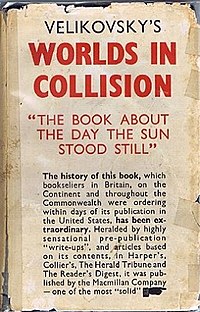Worlds in Collision

First UK edition (publ. Gollancz)
|
|
| Author | Immanuel Velikovsky |
|---|---|
| Country | USA |
| Language | English |
| Genre | science fiction |
| Published | 3 April 1950 |
Worlds in Collision is a book written by Immanuel Velikovsky and first published April 3, 1950. The book postulated that around the 15th century BCE, Venus was ejected from Jupiter as a comet or comet-like object, and passed near Earth (an actual collision is not mentioned). The object changed Earth's orbit and axis, causing innumerable catastrophes that were mentioned in early mythologies and religions around the world. Many of the book's claims are completely rejected by the established scientific community as they are not supported by any available evidence.
The book was first published on April 3, 1950, by Macmillan Publishers. Macmillan's interest in publishing it was encouraged by the knowledge that Velikovsky had obtained a promise from Gordon Atwater, Director of the Hayden Planetarium, for a sky show based on the book when it was published. The book, Velikovsky's most criticized and controversial, was an instant New York Times bestseller, topping the charts for eleven weeks while being in the top ten for twenty-seven straight weeks. Despite this popularity, overwhelming rejection of its thesis by the scientific community forced Macmillan to stop publishing it and to transfer the book to Doubleday within two months.
In the book's preface, Velikovsky summarized his arguments:
The book proposed that around the 15th century BCE, Venus was ejected from Jupiter as a comet or comet-like object, passed near Earth (an actual collision is not mentioned). The object changed Earth's orbit and axial inclination, causing innumerable catastrophes which were mentioned in early mythologies and religions around the world. Fifty-two years later, it passed close by again, stopping the Earth's rotation for a while and causing more catastrophes. Then, in the 8th and 7th centuries BCE, Mars (itself displaced by Venus) made close approaches to the Earth; this incident caused a new round of disturbances and disasters. After that, the current "celestial order" was established. The courses of the planets stabilized over the centuries and Venus gradually became a "normal" planet.
...
Wikipedia
